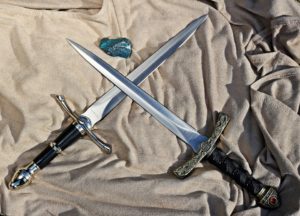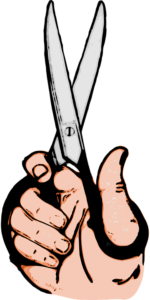 A longsword does a d8, right? A greataxe does a d12, a dagger does a d4, and longbows can fire arrows accurately at
A longsword does a d8, right? A greataxe does a d12, a dagger does a d4, and longbows can fire arrows accurately at  a distance of 100 feet. That’s just how it is. Using the default D&D weapon chart, at least. Really, though, why does a slashing and piercing weapon that does a d4 need to be a dagger? Wouldn’t it be just as reasonable to say that the d4 damage comes from a pair of scissors that a tailor uses to defend himself? No need to say it’s an improvised weapon. After all, this tailor knows those scissors better than any cutpurse knows a dagger.
a distance of 100 feet. That’s just how it is. Using the default D&D weapon chart, at least. Really, though, why does a slashing and piercing weapon that does a d4 need to be a dagger? Wouldn’t it be just as reasonable to say that the d4 damage comes from a pair of scissors that a tailor uses to defend himself? No need to say it’s an improvised weapon. After all, this tailor knows those scissors better than any cutpurse knows a dagger.
“Longsword”, “greataxe”, “dagger”, and “longbow” are all just labels given to the mechanical constructs of damage and properties a player character uses in combat. If one were to remove those labels, the mechanical impact of these generic weapons would be identical, barring unique house rules. As such, why restrict players, GMs, or the mechanics as a whole to the narrative explanations offered by default by an RPG manual?
Redefining the narrative description of mechanical constructs is often called “refluffing”. The term comes from the commonly accepted distinction between mechanical game rules (crunch) and narrative aspects of an RPG (fluff). Crunch can be difficult to alter without causing unintended results. It can also take a lot of work to devise an entirely new set of mechanics to incorporate new ideas into a game. Fluff, on the other hand, is mutable. If a GM or player wants to change a bit of fluff in a game, it’s as easy as saying it is so.
Let’s use the tailor’s scissors as an example. Some GMs may see it necessary to assign new stats to these shears. “The scissors are brittle, so they’ll break if you roll a one. Oh, and they come apart, so they apply a minus one in frantic combat.” These rule changes might seem benign, but it will take some time to see the effects. Even on the surface, these rules will likely slow down play by making players do more mental math, and it’s one more thing to track on a die roll. An easier, simpler, and more satisfying alternative may be refluffing.
Typically, a person who wants to refluff something searches for mechanics that already exist in the game, and simply change the label assigned to the statistics. For the daring tailor who brings his profession into battle, it would make sense to use a dagger’s statistics. The scissors can stab pretty well, but they’re small, so a d4 makes sense. They would probably be easily maneuverable, so finesse makes sense as well. Throwing the scissors seems just as practical as throwing a dagger, as long as the scissors are well maintained.
Weapons aren’t the only thing that can be refuffed, of course. Armor can be made out of different materials, for example. The statistics of fullplate could be used for a parasitic exoskeleton that has formed over a cursed warrior. Furthermore, statistical adjustments for races can easily be used for exotic ideas that aren’t provided by the book. Say a player wants to play a kobold, and the group doesn’t have access to any official stats for the race. Instead of homebrewing a list of racial features, it could be as easy as writing “kobold” on the race line of your character sheet, and using the Halfling stats. Both races are small, agile, and sneaky. Depending on the game, some small tweaks may be preferable, but in others, it might be perfect. Even abilities and spells can be refluffed to create unique characters. A barbarian’s rage may not be a primal fury, but the spiritual guidance of an ancestor who controls the body of the adventurer. The fighter’s 4 attacks could simply be one massive swing that does the damage of many swipes. Even a wizard’s spellbook might be changed to a prayerbook of religious songs that have been known to curry a god’s favor.
Refluffing is a powerful tool that can increase possibilities in an otherwise restrictive RPG. The only limit is a group’s creativity. Next time the story calls for a changeling who wields two pillars of light to protect himself from a crabshell-wearing ettin, don’t despair at the lack of mechanics. Instead, look at what the game already offers, and attach whatever labels are needed for the situation. After all, a d6 by any other name is still the same shape.


Unless you actually have a SCISOR-DAGGER!
https://s-media-cache-ak0.pinimg.com/originals/3e/99/8a/3e998a15f4e91d0380adc7cbdc8ff08b.jpg
I like those. Those a really cool. Might even lend some support to the idea, yes? :p
I like giving people the opportunity to personalize what they are using. Thanks for some insights.